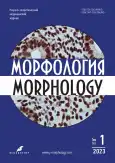Distribution of connexin 43 in the human pineal gland
- Authors: Sufieva D.A.1, Fedorova E.A.1, Yakovlev V.S.1, Grigor’ev I.P.1
-
Affiliations:
- Institute of Experimental Medicine
- Issue: Vol 161, No 1 (2023)
- Pages: 19-26
- Section: Original Study Articles
- Submitted: 07.09.2023
- Accepted: 26.09.2023
- Published: 15.01.2023
- URL: https://j-morphology.com/1026-3543/article/view/569156
- DOI: https://doi.org/10.17816/morph.569156
- ID: 569156
Cite item
Abstract
BACKGROUND: Connexin 43 (Cx43) is one of the important gap junction proteins of astrocytes and is necessary for intercellular communication. To date, data on gap junctions in the human pineal gland are limited, and Cx43 has not been examined in this organ.
AIM: This study aimed to investigate the distribution of gap junctions in the human pineal gland by simultaneous detection of Cx43 and the astrocyte marker glial fibrillary acidic protein (GFAP).
METHODS: Fixed and paraffin-embedded samples of the human pineal gland (n=4) were used. The study participants were between 19 and 34 years old. For the simultaneous detection of Cx43 and GFAP in the human pineal gland, immunohistochemistry was used, followed by analysis using an LSM 800 confocal laser scanning microscope (Carl Zeiss, Germany).
RESULTS: For the first time, our immunohistochemical study showed the presence of Cx43 in the human pineal gland. The confocal microscopy with double immunolabeling of Cx43 and GFAP visualized the individual clusters of Cx43-containing structures that were undistinguishable under transmitted light microscopy and showed the localization of the Cx43 on the membrane of astrocytes.
CONCLUSION: The proposed method makes it possible to determine Cx43-positive structures in human pineal tissue, which are localized mostly in the area of astrocyte processes.
Full Text
About the authors
Dina A. Sufieva
Institute of Experimental Medicine
Author for correspondence.
Email: dinobrione@gmail.com
ORCID iD: 0000-0002-0048-2981
SPIN-code: 3034-3137
Cand Sci (Biol.)
Russian Federation, Saint PetersburgElena A. Fedorova
Institute of Experimental Medicine
Email: el-fedorova2014@yandex.ru
ORCID iD: 0000-0002-0190-885X
SPIN-code: 5414-4122
Cand. Sci. (Biol.)
Russian Federation, Saint PetersburgVladislav S. Yakovlev
Institute of Experimental Medicine
Email: 1547053@mail.ru
ORCID iD: 0000-0003-2136-6717
SPIN-code: 7524-9870
Russian Federation, Saint Petersburg
Igor P. Grigor’ev
Institute of Experimental Medicine
Email: ipg-iem@yandex.ru
ORCID iD: 0000-0002-3535-7638
SPIN-code: 1306-4860
Cand Sci (Biol.)
Russian Federation, Saint PetersburgReferences
- Gheban BA, Rosca IA, Crisan M. The morphological and functional characteristics of the pineal gland. Med Pharm Rep. 2019;92(3):226–234. doi: 10.15386/mpr-1235
- Samanta S. Physiological and pharmacological perspectives of melatonin. Arch Physiol Biochem. 2022;128(5):1346–1367. doi: 10.1080/13813455.2020.1770799
- Ahmad SB, Ali A, Bilal M, et al. Melatonin and health: insights of melatonin action, biological functions, and associated disorders. Cell Mol Neurobiol. 2023;43(6):2437–2458. doi: 10.1007/s10571-023-01324-w
- Coon SL, Fu C, Hartley SW, et al. Single cell sequencing of the pineal gland: the next chapter. Front Endocrinol (Lausanne). 2019;10:590. doi: 10.3389/fendo.2019.00590
- Eugenin EA, Valdebenito S, Gorska AM, et al. Gap junctions coordinate the propagation of glycogenolysis induced by norepinephrine in the pineal gland. J Neurochem. 2019;151(5):558–569. doi: 10.1111/jnc.14846
- Møller M, Midtgaard J, Qvortrup K, Rath MF. An ultrastructural study of the deep pineal gland of the Sprague Dawley rat using transmission and serial block face scanning electron microscopy: cell types, barriers, and innervation. Cell Tissue Res. 2022;389(3):531–546. doi: 10.1007/s00441-022-03654-5
- Huang SK, Taugner R. Gap junctions between guinea-pig pinealocytes. Cell Tissue Res. 1984;235(1):137–141. doi: 10.1007/BF00213733
- García-Mauriño JE, Boya J. Postnatal development of the rabbit pineal gland. A light- and electron-microscopic study. Acta Anat (Basel). 1992;143(1):19–26. doi: 10.1159/000147224
- Berthoud VM, Hall DH, Strahsburger E, et al. Gap junctions in the chicken pineal gland. Brain Res. 2000;861(2):257–270. doi: 10.1016/s0006-8993(00)01987-9
- Omura Y. Pattern of synaptic connections in the pineal organ of the ayu, Plecoglossus altivelis (Teleostei). Cell Tissue Res. 1984;236(3):611–617. doi: 10.1007/BF00217230
- Moller M. The ultrastructure of the human fetal pineal gland. I. Cell types and blood vessels. Cell Tissue Res. 1974;152(1):13–30. doi: 10.1007/BF00224208
- Belluardo N, Trovato-Salinaro A, Mudò G, et al. Structure, chromosomal localization, and brain expression of human Cx36 gene. J Neurosci Res. 1999;57(5):740–752.
- Korzhevskii DE, editor. Morfologicheskaja diagnostika. Podgotovka materiala dlja gistologicheskogo issledovanija i jelektronnoj mikroskopii: rukovodstvo. Saint Petersburg: SpecLit; 2013. (In Russ).
- Sufieva DA, Kirik OV, Korzhevskii DE. Astrocyte markers in the tanycytes of the third brain ventricle in postnatal development and aging in rats. Russ J Dev Biol. 2019;50:146–153. doi: 10.1134/S1062360419030068
- Korzhevskij DJe. Osobennosti ispol’zovanija immunogistohimicheskih metodov pri provedenii jeksperimental’nyh issledovanij. In: Odincova IA, Kostjukevich SV, editors. Voprosy morfologii XXI veka. Vypusk 6. Sbornik nauchnyh trudov Vserossijskoj nauchnoj konferencii “Gistogenez, reaktivnost’ i regeneracii tkanej”; 2021 May 13–14, Saint Petersburg. Saint Petersburg: “Izdatel’stvo DEAN”; 2021. P. 45–48. (In Russ).
- Beznin GV, Sufieva D., Korzhevskij DJe. Razlichija v rezul’tatah reakcii na belok C23 pri vyjavlenii ego v nejronah gippokampa raznymi sposobami. In: Sbornik materialov III Vserossijskoj molodjozhnoj konferencii s mezhdunarodnym uchastiem, posvjashhjonnoj 100-letiju Fiziologicheskogo obshhestva im. I.P. Pavlova; 2017 Oct 23–25; Saint Petersburg. Saint Petersburg: Institut jeksperimental’noj mediciny; 2017. P. 27–30. (In Russ).
- Karpenko MN. Sovremennye metody mikroskopii, osnovannye na ispol’zovanii jeffekta fluorescencii. In: Korzhevskij DJe, editor. Immunocitohimija i konfokal’naja mikroskopija. Saint Petersburg: SpecLit; 2018. P. 8–19. (In Russ).
- Tovey SC, Brighton PJ, Bampton ET, et al. Confocal microscopy: theory and applications for cellular signaling. Methods Mol Biol. 2013;937:51–93. doi: 10.1007/978-1-62703-086-1_3
- Hodson DJ, Legros C, Desarménien MG, Guérineau NC. Roles of connexins and pannexins in (neuro)endocrine physiology. Cell Mol Life Sci. 2015:72(15):2911–2928. doi: 10.1007/s00018-015-1967-2
Supplementary files








